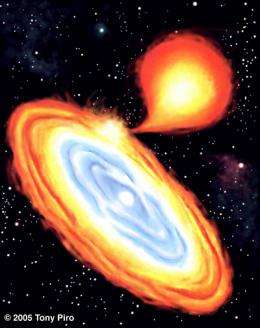Using supercomputers to understand the super stars of the cosmos

(PhysOrg.com) -- Is it a high-speed graphic animation of a yellow-golden cauliflower erupting in fast motion? No. Maybe it's some kind of time-lapse, computer-generated X-ray of a brain as it grows over years. No.
It's one of many images Princeton University astrophysicist Adam Burrows has conjured up, using supercomputers to simulate an explosion deep within a star called a supernova. It's not a run-of-the-mill thermonuclear explosion that fuels a healthy star. Instead, it's the kind of explosion that seals a star's fate.
"The rest of the star, its surface, and most of its mass are completely oblivious to its impending fate, but the explosion, which will take just a few seconds, will propagate through the star on periods of hours to a day," explains Burrows.
With help from the National Science Foundation (NSF), Burrows uses supercomputers to create spectacular 3-D images of supernovae that allow him to peer inside these super stars just before they explode.
"One of the things we discovered is that it doesn't explode as a ring expanding out. It explodes in tendrils and fingers, very turbulently," continues Burrows. "The material that's ejected in the supernovae will then start to collapse. Some of that gas will form the next generation of stars and you'll go through the same cycle again."
Supernovae are also the source of many of the heavy elements of nature. In fact, without them, there would be no "us!"
"Some of the heavy elements manufactured in supernovae include the calcium that's in your bones, the fluoride in your toothpaste, and the iron in your blood," says Burrows.
It takes a lot of star power to make those elements. "When supernovae explode, they release the equivalent of 10 to the 28th [or ten octillion] megatons of TNT in energy. One megaton alone is the explosive equivalent of one of the largest hydrogen bombs," Burrows points out.
The computer simulations of supernovae are created using complex mathematical models and take months to process. "Being able to understand the explosions with these simulations is a milestone in theoretical astrophysics," notes Burrows.
Only stars that have about eight times the mass of our sun will die this type of violent death. Burrows says that our sun is a pretty boring star compared to what else is out there.
Provided by National Science Foundation















